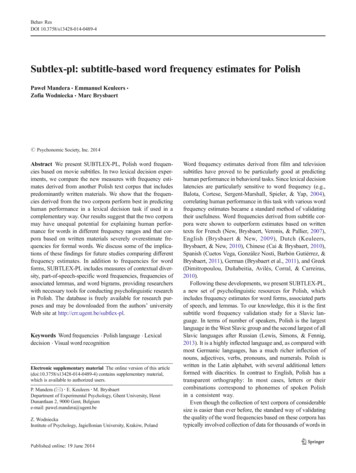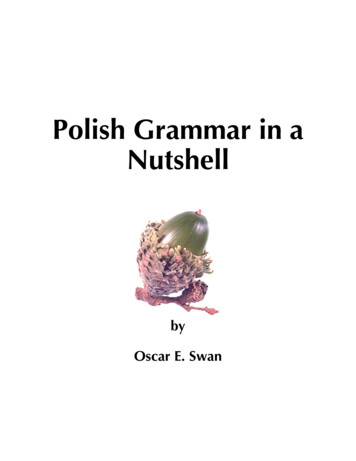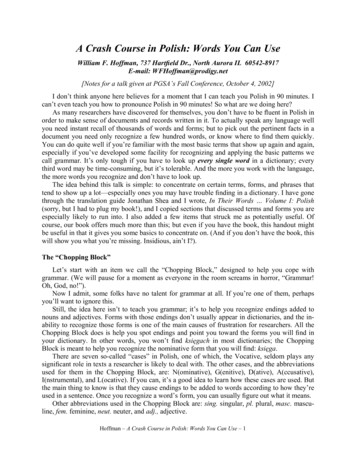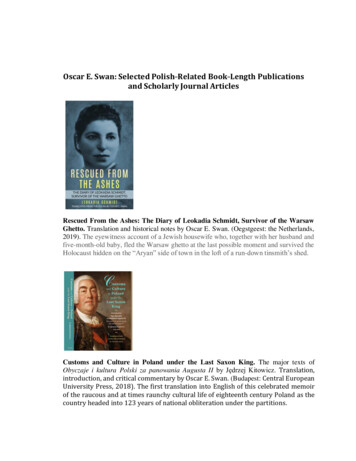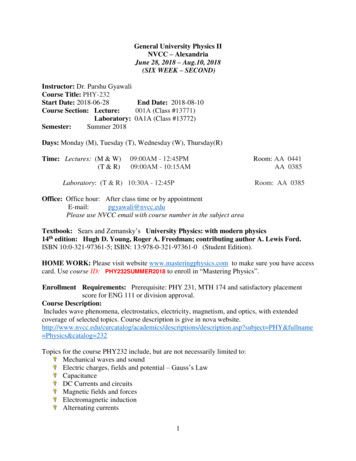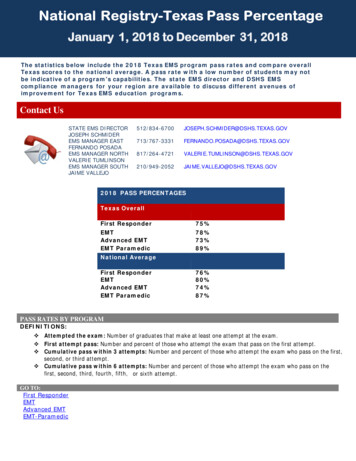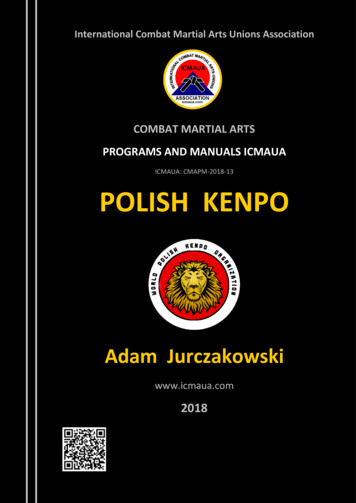
Transcription
Adam Jurczakowski (2018): Polish Kenpo. -Combat Martial Arts programms and manuals ICMAUA, V.013.,www.icmaua.com: 29 p.International Combat Martial Arts Unions AssociationCOMBAT MARTIAL ARTSPROGRAMS AND MANUALS ICMAUAICMAUA: CMAPM-2018-13POLISH KENPOAdam Jurczakowskiwww.icmaua.com20181
Adam Jurczakowski (2018): Polish Kenpo. -Combat Martial Arts programms and manuals ICMAUA, V.013.,www.icmaua.com: 29 p.Combat Martial Arts programs and manuals ICMAUA publishes original programs,syllabuss, and manuals of Martial Arts styles, organizations and schools: trainingsmethods, belts (Kyu, Dan) and exams requirements, education methods andphilosophy.Combat Martial Arts programs and manuals ICMAUA will be published after receivingof materials from authors - members of the ICMAUACombat Martial Arts programs and manuals ICMAUA is published in a PDF formatand is placed in free access in the Library of Combat Martial Arts manuals andprogramms ICMAUA (www.icmaua.com). Authors don’t receive any money for theirbooks.Combat Martial Arts programs and manuals ICMAUA publishes original papers "as iswritten by author", without any changes (also grammatical or stylistic) in the basictext. Changes in design are possible.Combat Martial Arts programs and manuals ICMAUA is free distributed tomembers from the countries: Afghanistan, Algeria, Angola, Argentina, Australia,Austria, Azerbaijan, Bahrain, Bangladesh, Belarus, Belgium, Bosnia & Herzegovina,Brazil, Bulgaria, Cameroon, Canada, Chile, China, Costa Rica, Croatia, Denmark,Egypt, France, Finland, Germany, Georgia, Ghana, Greece, Guam, Guyana, Haiti,Hungary, India, Indonesia, Iran, Iraq, Ireland, Israel, Italy, Jamaica, Japan,Kazakhstan, Kuwait, Latvia, Luxembourg, Malaysia, Maldives, Malta, Mauritius,Mexico, Montenegro, Morocco, Nepal, Netherlands, New Zealand, Nigeria, NorthKorea, Norway, Pakistan, Peru, Philippines, Poland, Portugal, Puerto Rico,Romania, Russia, Saint Lucia, Saudi Arabia, Scotland, Serbia and Montenegro,Sierra Leone, Singapore, Slovenia, South Africa, South Korea, Spain, Sri Lanka,Sudan, Sweden, Switzerland, Syria, Tajikistan, Thailand, Trinidad and Tobago,Tunisia, Turkey, Uganda, Ukraine, United Arab Emirates, United Kingdom, UnitedStates of America, Uruguay, Uzbekistan, Venezuela, Yemen, Yugoslavia.DisclaimerThe full responsibility for the published material belongs to the authors.The publisher, editors of the Combat Martial Arts programs and manualsICMAUA and ICMAUA disclaim responsibility for any liability, injuries, ordamages.Address for correspondence: info@icmaua.com2
Adam Jurczakowski (2018): Polish Kenpo. -Combat Martial Arts programms and manuals ICMAUA, V.013.,www.icmaua.com: 29 p.INTRODUCTIONKenpo in translation from Japanese means the method of a fist or an art of a fist.Polish Kenpo is a style of fighting created in Poland in 2016 by Adam Jurczakowski.He is Master in Political Science and Doctor of Philosophy in Martial Arts. The creatorof this style was born on 5th February 1967 in Warsaw. He has been practisingmartial arts since 1983. The inspiration to create a separate martial art were: Ju-jitsu,Karate Shotokan, Kenpo Karate (American Kempo) and Kick-boxing.Polish Kenpo puts great attention on education in the area of martial arts (both theoryand practice) and on real self-defense. The creator of the style does not recommendsport competition as it is based on conventionally accepted rules. In sport fighting it isallowed to use particular techniques only in aim to defeat the opponent ( imposedrules) and achieve fame and money. So in fact it is not a real fight. In real selfdefense there is no rules and when fighting in self- defense one aims to save their lifeand health. So our goal should be self-improvement and achieving maximumeffectiveness in self- defense. Summing up sport competition ought to be treated assome kind of supplement. It cannot become our aim itself as we risk martial artdistortion and losing our ability of real self-defense what is the assumption of PolishKenpo.Acquired skills should be in principle presented only in dojo (a training room) or whiletraining in the open area. Exceptional circumstances are: possible martial arts showsand competitions, self-defense and defense of the weaker. The organization whichbrings together training people and their supporters is WORLD POLISH KENPOORGANIZATION (WPKO) whose founder and president is Adam Jurczakowski.WPKO is a member of a worldwide federation INTERNATIONAL COMBATMARTIALARTSUNIONSASSOCIATION (ICMAUA) gathering severalorganizations and a great number of individual members.WPKO has implemented Japanese terminology and naming. It is undoubtedly a nodtowards traditional martial arts of Japanese background.Traditional martial arts are of the most respect and ought to be treated as a sourcefrom which one should get as much as possible. But they cannot be the limits. PolishKenpo is a martial art which is supposed to develop. New elements from differentparts of the world should be added. Creative inventiveness of the Masters of PolishKenpo seems to be a very important factor. Every Master (a person who gained themaster level) is obliged to express themselves through martial art as well as developand popularize it as part of their abilities.3
Adam Jurczakowski (2018): Polish Kenpo. -Combat Martial Arts programms and manuals ICMAUA, V.013.,www.icmaua.com: 29 p.Soke Adam Jurczakowski 10 Dan, a creator of Polish Kenpo.4
Adam Jurczakowski (2018): Polish Kenpo. -Combat Martial Arts programms and manuals ICMAUA, V.013.,www.icmaua.com: 29 p.DEGREES OF INITIATIONS AND TITLES IN POLISH KENPOThere are nine students'degrees kyu (from 9 to 1) and ten masters' degrees dan(from 1 to 10). Kyu levels exams can be performed by every examiner who has amaster level dan ( an owner of 1 dan is authorized to give every level to 1 kyu). Togive master levels dan an examiner must have a level of initiation at least two levelshigher than an applicant (for example to give a degree 2 dan one must have at least4 dan). Exams are taken to 9 dan but the highest degree 10 dan is given foroutstanding achievements and contributions for martial arts development.In exceptional cases, soke can award degrees of honour. However, they do notentitle to conduct training and examination. Degrees must be confirmed withappropriate certificates. For giving seriousness, the examiner can create acommission that will consist of two or three people. The examiner may be a personwith a master level who has been authorized by soke (the authorization may bewithdrawn), with grades 9 and 10 dan, it may only be issued by soke (the leader ofthe Polish Kenpo style). Currently, it is Adam Jurczakowski, who himself has 10 dan,because he created a style, defined the principles and techniques of this style andrequirements for particular levels of initiation. His degree has been confirmed byrelevant certificates issued by ICMAUA, WKKO Kenpokaikan and World Council ofBlack Belts (WCBB).Soke can indicate his successor (another soke and WPKO president) during hislife or in his will. If he does not, the master of the style will be the master whocurrently has the highest degree of dan. If there are more champions with thisdegree, the leader will be selected through voting. Only people with the Polish Kenpochampionship can vote, and each of them can cast only one vote.Soke automatically becomes a WPKO president and these functions cannot beseparated into two people. The new soke automatically achieves a 10 dan degree.The leader of the organization can choose to help (at his own discretion)representatives, i e the secretary general and regional directors.Persons with a master's degree are entitled to the honorable sensei title (master,teacher). If the instructor does not have a master's degree, he has the right to use thetitle senpai (senior). In addition, soke can award the following honorary titles tooutstanding masters:1) renshi (multiple master) at 5 dan,2) kyoshi (outstanding master) at 6 dan,3) shihan (grand master) at 7 and 8 dan,4) hanshi (master of champions) at 9 and 10 dan.Requirements for individual student and master classes along with the colors ofthe belts will be provided at the end of this study.In the case of meritorious people for the promotion and dissemination of martialarts, written acknowledgments, congratulations, honorary memberships of theWPKO, honorary black belts, commemorative medals and orders of merit of theWPKO can be granted. They can be awarded by soke (President of WPKO) on theirown initiative or at the request of the Secretary General.The World Polish Kenpo Organization also provides instructor courses. They areorganized by soke or a master authorized by him. In addition, self-defense coursesand courses of tactics and intervention techniques are organized.5
Adam Jurczakowski (2018): Polish Kenpo. -Combat Martial Arts programms and manuals ICMAUA, V.013.,www.icmaua.com: 29 p.TRAINING OUTFITDuring Polish Kenpo training, a special outfit named keiko is recommended. It is verydurable, breathable and well absorbs sweat. In addition, it provides freedom ofmovement, which is extremely important during training. to meet all theserequirements, clothing should be made of pure cotton. Keiko-gi consists of threeparts: kimono (upper part of the outfit), hakama (pants) and obi (belt). WPKO allowscostumes in black or red. The color of the belt depends on the degree of initiation. Allstudents during training, demonstration or competition must be uniformly dressed(black or red). A stripe or embroidery with the WPKO logo is to be placed on the leftchest. On the left shoulder there may be a second patch or embroidery with the logoof the club or section belonging to WPKO. Persons conducting training, or instructors(regardless of their degree) have a special privilege, do not need to adapt to others,decide for themselves whether they dress in black or in red. In exceptional cases,soke may issue permission to use costumes with a different cut and color.CEREMONIALYou should enter the dojo barefoot or in a special training shoe. Every time youenter and leave, it is obligatory to face the room and make a bow in a standingposition (tachi – rei). The same greeting should be given to all current masters andinstructors who do not have a master degree.At the beginning and at the end of the training, the students stand in a row (orseveral rows, if there are a lot of them) from right to left, according to the degree ofseniority. In the tachi-zen position (musubi-dachi), the teacher performs a bow towhich the students answer the seiza command, all sit down in order of advancement,kneeling first on the left knee (the leader sits first).The instructor, sitting opposite the practitioners, gives the command otagai - ni rei (mutual nod). Then the teacher makes a bow in the sitting position (for -rei), whichthe students immediately answer. Once the bows have been exchanged, theinstructor issues a mokuso command. It is a signal to start relaxation and breathingexercises. Thanks to them, we can relax and mentally prepare for training. Themokusoyame command completes relaxation and breathing exercises. Then thestudents listen to what the instructor has to say and at his command kiritsu wake up(he gets up first).At the end, a bowing in a standing position is again performed (the instructorbows first). There are also special bows for the master (teacher) and the creator ofPolish Kenpo.The practitioner, called to the trainer, or addressing him, bows in a standingposition, which should be immediately reciprocated. A person who is late for training,bows in a standing position, then sits at the entrance to the dojo in a position of zazen and only on the sign given by the teacher joins the group of exercisers.TECHNIQUES USED IN POLISH KENPOPolish Kenpo is an extremely versatile martial art. So it has a very wide range oftechniques. We find here many techniques of Ju-Jitsu, Karate and Kick-boxing. Inaddition, there are techniques of fighting with the use of weapons. All thesetechniques can be combined into an infinite number of combinations. Each champion6
Adam Jurczakowski (2018): Polish Kenpo. -Combat Martial Arts programms and manuals ICMAUA, V.013.,www.icmaua.com: 29 p.can choose what he thinks best suited to real self-defense. New techniques and theircombinations can be introduced as well as new types of weapons. Currently, thebasic division of techniques into particular groups is as follows:1) tachi-waza - standing positions,2) ukemi-waza - pads,3) kawashi-waza - dodges,4) uke-waza - blocks,5) tsuki-waza - sticks,6) uchi-waza - impacts,7) keri-waza - kicks,8) kuzushi-waza - tearing, pulling out,9) osae-waza - pressures,10) nage-waza - projections,11) taosu-waza - overthrow,12) kari-waza - undercuts,13) osaekomi-waza - holding, immobilizing,14) kansetsu-waza - levers,15) shime-waza - suffocation,16) beech-waza - weapons combating techniques,17) techniques used in kick-boxing and boxing.The most frequently used fighting techniques included in selected groups arelisted below.TACHI - WAZA: heisoku-dachi, musubi-dachi, hachiji-dachi, zenkutsu-dachi, kibadachi, kokutsu-dachi, neko-ashi-dachi, sanchin-dachi.Sensei Agnieszka Ciesielska 1st dan is presenting the position zenkutsu-dachi.7
Adam Jurczakowski (2018): Polish Kenpo. -Combat Martial Arts programms and manuals ICMAUA, V.013.,www.icmaua.com: 29 p.UKEMI – WAZA : zenpo-ukemi, zenpo-kaiten-ukemi, yoko-ukemi, koho-ukemi, kohokaiten-ukemi.Sensei Agnieszka Ciesielska 1st dan is presenting a pad yoko-ukemi performed afterthrowing.UKE – WAZA: age-uke, otoshi-uke, soto-ude-uke, uchi-ude-uke, gedan-barai, tenagashi-uke, teisho-uke, sukui-uke, shuto-uke, juji-uke, morote-uchi-uke, kakiwakeuke, ashibo-uke.8
Adam Jurczakowski (2018): Polish Kenpo. -Combat Martial Arts programms and manuals ICMAUA, V.013.,www.icmaua.com: 29 p.Sensei Agnieszka Ciesielska 1st dan is presenting a block uchi-ude-uke in theposition of kib
Polish Kenpo puts great attention on education in the area of martial arts (both theory and practice) and on real self-defense. The creator of the style does not recommend sport competition as it is based on conventionally accepted rules. In sport fighting it is allowed to use particular techniques only in aim to defeat the opponent ( imposed
